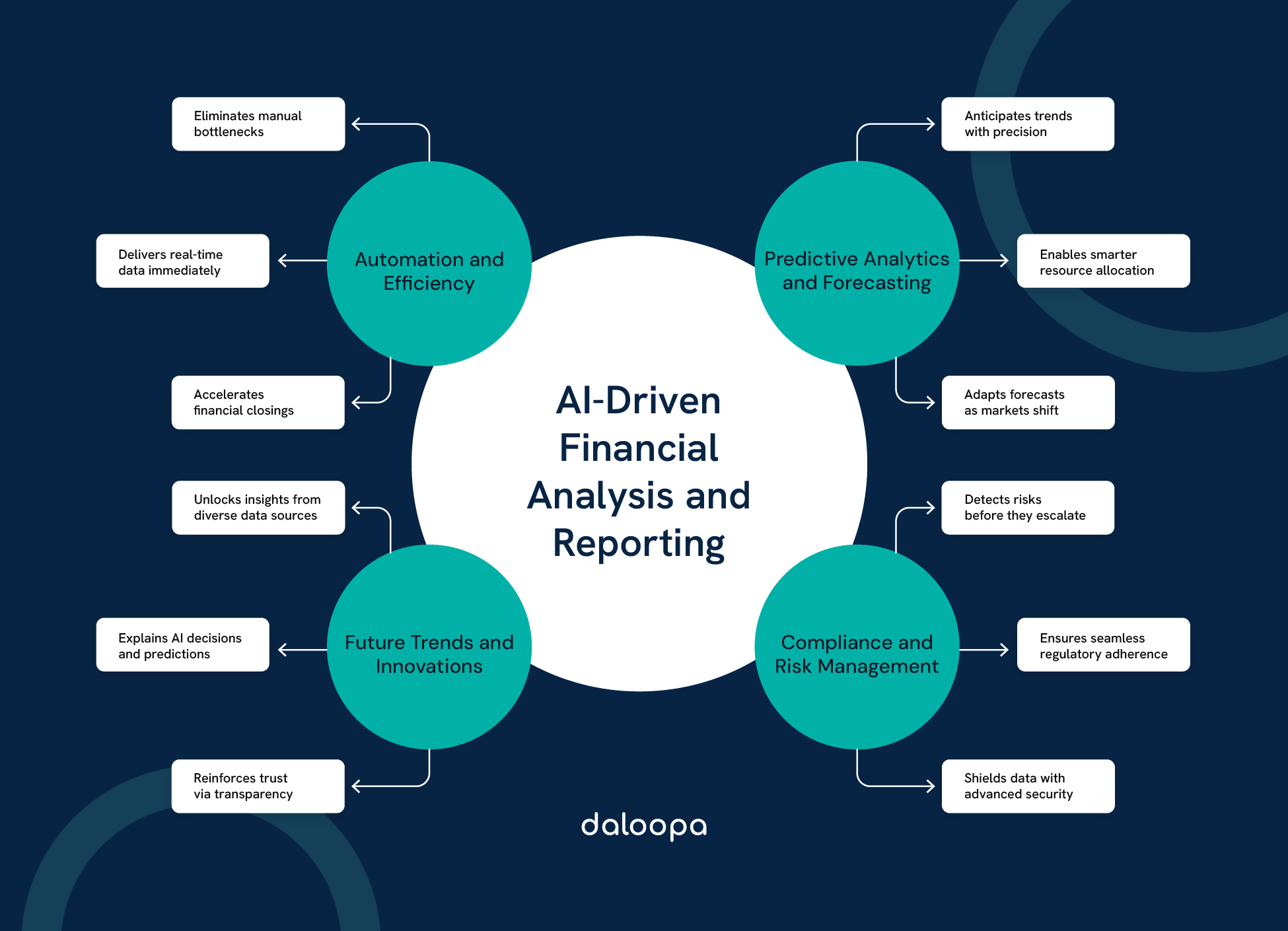Artificial intelligence transforms financial analysis and reporting, reshaping how organizations manage, interpret, and share financial data. It automates processes, enhances accuracy, and delivers actionable insights, enabling smarter, more strategic decision-making. This is how AI enhances financial analysis and reporting, making it an essential tool for modern finance teams.
Businesses face increasing competition and regulatory scrutiny, pressuring finance teams to operate more precisely and efficiently. AI-driven solutions help organizations meet these challenges and revolutionize the entire financial landscape.
This article explores four key areas where AI drives change and provides actionable insights on leveraging its potential.
Key Takeaways
- AI automates financial reporting, improving accuracy, efficiency, and reliability.
- Predictive analytics enhances forecasting, enabling better planning and preparation.
- Effective AI adoption requires thoughtful planning, robust governance, and human oversight.

1. Automation and Efficiency
Understanding how AI enhances financial analysis and reporting is crucial for leveraging its full potential. AI redefines financial processes with unprecedented efficiency, replacing traditional workflows with streamlined, automated solutions. Automation impacts every stage of AI-driven financial analysis and reporting, enabling organizations to achieve more in less time.
Transforming Financial Processes
AI technologies like robotic process automation (RPA) take on repetitive tasks such as data entry, reconciliations, and report generation. Automated systems reduce the time required to complete these tasks and minimize human errors that can lead to costly mistakes. Natural language processing (NLP) capabilities enhance efficiency by extracting key data from lengthy financial documents with remarkable accuracy.
For instance, finance teams that once spent hours manually consolidating information for monthly closings can now rely on AI to prepare accurate reports in minutes, freeing up valuable resources for strategic planning and other critical initiatives. Many organizations have reported a dramatic reduction in the time required to close books, with some reducing the process from weeks to just a few days.
AI also simplifies the creation of financial statements such as balance sheets and income reports. Automating these processes accelerates timelines, reduces discrepancies, and allows organizations to focus on interpreting results rather than compiling data.
Real-Time Insights and Analysis
AI’s ability to process vast amounts of data in real-time has transformed financial decision-making. Algorithms monitor transactions continuously, identifying trends, anomalies, and patterns that might otherwise go unnoticed. Rapid analysis allows finance teams to respond proactively to risks, opportunities, or shifts in market dynamics.
Real-time dashboards powered by AI provide instant access to key metrics such as cash flow, profitability, and budget utilization. With these automated reporting tools, finance professionals no longer need to rely solely on historical reports—they can make agile, informed decisions that adapt to the latest information.
2. Predictive Analytics and Forecasting
AI-driven forecasting tools enable organizations to make more informed predictions about future financial scenarios, improving planning, budgeting, and resource allocation.
Unlocking Predictive Insights
Machine learning (ML) models analyze large datasets to uncover patterns and relationships that traditional methods might miss. AI-driven financial analysis provides deeper insights into potential outcomes by processing historical financial data alongside external variables such as market conditions, regulatory changes, and economic trends.
These predictive capabilities empower finance teams to forecast revenue, anticipate risks, optimize pricing strategies, and evaluate investment opportunities. The adaptability of AI ensures that predictions remain relevant as new data becomes available.
For example, a company that integrates AI-driven forecasting into its operations can quickly adjust its projections in response to economic fluctuations or unexpected market developments.
Enhancing Forecast Accuracy
Traditional forecasting often relies on static models with limited capacity to account for complex, non-linear relationships between variables. AI-driven financial analysis addresses these limitations by leveraging advanced algorithms capable of detecting subtle correlations and learning from new data. As a result, forecasts become more precise and better aligned with real-world outcomes.
AI-driven financial analysis has been transformative for industries that rely heavily on accurate forecasting, such as retail, manufacturing, and finance. Sales projections, budget planning, and risk assessments are now supported by robust, data-driven insights that were previously unattainable.
3. Compliance and Risk Management
AI is reshaping how organizations approach compliance and risk management, providing automated reporting tools that enhance accuracy, transparency, and efficiency.
Simplifying Regulatory Compliance
AI systems streamline compliance by automating the analysis of regulatory requirements and identifying potential issues before they become liabilities. These automated reporting tools are designed to adapt to evolving regulations, helping organizations stay ahead of changes and avoid penalties.
For example, machine learning algorithms can analyze financial transactions in real-time, flagging discrepancies or potential violations. Automated reporting tools further simplify compliance by generating accurate, timely submissions that meet regulatory standards.
AI-powered encryption and anomaly detection systems safeguard sensitive financial information, ensuring that organizations meet stringent data protection requirements. This is particularly vital in industries such as banking, healthcare, and insurance, where maintaining customer trust is paramount.
Strengthening Risk Management
AI enhances risk management by providing finance professionals with more accurate automated reporting tools for assessing and mitigating potential threats. Machine learning models analyze historical data to identify patterns and trends, enabling organizations to predict and respond to risks more confidently.
For instance, real-time fraud detection systems powered by AI monitor transactions for unusual activity, such as unauthorized access or suspicious payment patterns. These systems can flag potential issues immediately, allowing organizations to act swiftly before problems escalate.
Advanced credit scoring models also benefit from AI’s capabilities. By evaluating a wider range of variables, AI delivers fairer, more precise assessments of creditworthiness, reducing default risks and improving lending decisions.
4. Future Trends and Innovations
The rapid evolution of AI continues to introduce groundbreaking technologies and methodologies that are reshaping financial analysis and reporting.
The Advancing Role of AI
Emerging AI technologies are expanding the scope of financial analysis. Natural language processing enables organizations to analyze unstructured data, such as earnings calls and news articles, for actionable insights. Blockchain integration is improving the security and transparency of financial transactions, while explainable AI is making predictions and recommendations more transparent.
These advancements create opportunities for finance teams to conduct more comprehensive analyses, integrate qualitative and quantitative data, and develop better strategies aligned with organizational goals.
Learn more about how AI-powered tools help you collect and organize data efficiently from this video:
Preparing for AI-Driven Finance
Organizations must invest in education and infrastructure to fully embrace AI’s potential, including providing finance professionals with training in AI concepts, implementing scalable platforms, and developing governance frameworks that address ethical considerations. By taking these steps, businesses can ensure effective and responsible AI initiatives.
Guidelines for Successful AI Adoption
To maximize the benefits of AI, finance professionals should adhere to these best practices. These steps are crucial in how AI enhances financial analysis and reporting, ensuring seamless integration and maximum efficiency.:
- Set Clear Objectives
Identify specific goals for AI adoption and align them with overall business strategies. - Foster AI Literacy
Equip teams with the knowledge and skills needed to work effectively with AI technologies. - Ensure Data Quality
Implement robust governance practices to maintain clean, accurate, and accessible data. - Start Small and Scale Gradually
Test AI initiatives on smaller projects before expanding to broader applications. - Prioritize Ethics and Transparency
Develop guidelines to ensure that AI-driven decisions are fair, unbiased, and transparent. - Engage Stakeholders
Communicate the benefits of AI adoption across all levels of the organization. - Monitor and Measure Performance
Regularly evaluate AI’s impact on processes and refine strategies as needed.
Why AI Matters in Financial Analysis
AI is transforming financial analysis and reporting by providing tools that enable professionals to work faster, smarter, and more effectively. Its key benefits include:
- Greater Accuracy: Automated systems minimize errors in data processing and reporting.
- Enhanced Speed: Tasks that once took days can now be completed in hours or minutes.
- Advanced Forecasting: AI-driven models deliver more precise predictions, enabling better planning.
- Improved Compliance: Real-time monitoring ensures regulatory adherence and protects sensitive data.
- Dynamic Insights: AI generates tailored reports and visualizations that enhance understanding.
- Proactive Decision-Making: Real-time analysis empowers organizations to respond swiftly to changes.
By leveraging these advantages, finance professionals can lead their organizations toward greater efficiency, resilience, and success. AI is not just a tool for the future—it’s a critical component of the present.
Improve Your Financial Analysis and Reporting with Daloopa’s AI Solutions
Ready to transform your AI-driven financial analysis? Daloopa’s advanced AI-powered solutions make it easy to automate repetitive tasks, generate real-time insights, and improve forecasting accuracy. Trusted by global institutions, Daloopa helps finance teams achieve unparalleled efficiency and precision.
Discover how AI enhances financial analysis and reporting by streamlining workflows, reducing errors, and delivering deeper insights for better decision-making.
Don’t just keep up with the future of finance—lead it. Explore how Daloopa can empower your organization to make smarter, faster decisions. Request a demo today and see AI in action.



